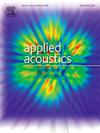张量LMS测定远距离室外声传递函数的实验分析
IF 3.4
2区 物理与天体物理
Q1 ACOUSTICS
引用次数: 0
摘要
在这项实验研究中,我们研究了张量最小均二乘(TLMS)算法与传统最小均二乘(LMS)方法在可变天气条件下确定远程室外声衰减传递函数的有效性。为了捕捉时变环境条件对声音传播的影响,我们在326米范围内进行了室外远程现场实验。输入信号为3秒线性扫描,范围从125赫兹到4千赫,每10分钟传输一次,持续一小时。我们持续监测天气状况,包括风速和风向。我们首先使用TLMS和LMS算法进行了收敛分析和脉冲响应评估。研究结果表明,TLMS在信道估计精度方面明显优于传统的最小均方误差(LMS)方法,其均方误差(MSE)约为10−38,而LMS的均方误差为10−8。这证明了TLMS对室外声道时变特性的优越适应性。随后,该研究通过光谱分析评估了传递函数,揭示了大气条件对声信号传播的影响,并为声通道的时变提供了见解。研究结果证实了TLMS在室外环境中进行高级声学建模的潜力,从而验证了其在实时声学传递函数估计中的实现。本文章由计算机程序翻译,如有差异,请以英文原文为准。
Experimental analysis of tensor LMS for determining the long-range outdoor acoustic transfer function
In this experimental study, we investigated the effectiveness of the Tensor Least Mean Squares (TLMS) algorithm compared to the traditional Least Mean Squares (LMS) method for determining long-range outdoor acoustic attenuation transfer functions under variable weather conditions. We conducted an outdoor long-range field experiment over a 326-meter range to capture the effect of time-varying environmental conditions on sound propagation. The input signal was a 3-second linear sweep ranging from 125 Hz to 4 kHz, transmitted every 10 minutes for an hour. We continuously monitored weather conditions, including wind speed and direction. We first conducted a convergence analysis and impulse response evaluation using both TLMS and LMS algorithms. Our results show that TLMS significantly outperforms the traditional Least Mean Squares (LMS) method in channel estimation accuracy, achieving a Mean Square Error (MSE) of approximately compared to for LMS. This demonstrates TLMS's superior adaptability to time-varying characteristics of outdoor acoustic channels. Subsequently, the study evaluated the transfer function through spectral analysis, revealing the impact of atmospheric conditions on acoustic signal propagation and providing insights into the time-variance of the acoustic channel. The findings confirm the potential of TLMS for advanced acoustic modeling in outdoor environments, thus validating its implementation for real-time acoustic transfer function estimation.
求助全文
通过发布文献求助,成功后即可免费获取论文全文。
去求助
来源期刊

Applied Acoustics
物理-声学
CiteScore
7.40
自引率
11.80%
发文量
618
审稿时长
7.5 months
期刊介绍:
Since its launch in 1968, Applied Acoustics has been publishing high quality research papers providing state-of-the-art coverage of research findings for engineers and scientists involved in applications of acoustics in the widest sense.
Applied Acoustics looks not only at recent developments in the understanding of acoustics but also at ways of exploiting that understanding. The Journal aims to encourage the exchange of practical experience through publication and in so doing creates a fund of technological information that can be used for solving related problems. The presentation of information in graphical or tabular form is especially encouraged. If a report of a mathematical development is a necessary part of a paper it is important to ensure that it is there only as an integral part of a practical solution to a problem and is supported by data. Applied Acoustics encourages the exchange of practical experience in the following ways: • Complete Papers • Short Technical Notes • Review Articles; and thereby provides a wealth of technological information that can be used to solve related problems.
Manuscripts that address all fields of applications of acoustics ranging from medicine and NDT to the environment and buildings are welcome.
 求助内容:
求助内容: 应助结果提醒方式:
应助结果提醒方式:


